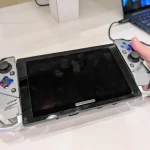
Actor Meyne Wyatt has won the Archibald Prize’s Packing Room Prize for his self-portrait.
The prize, announced by head packer Brett Cuthbertson on Thursday at the Art Gallery of NSW, was accompanied by the unveiling of the 55 finalists in this year’s Archibald Prize for portraiture – one of the country’s oldest and richest art awards, with a purse of $100,000.
The announcement kicks off “Archies season”, with concurrent exhibitions of the Wynne Prize (for landscape painting) and the Sulman Prize (for “subject painting, genre painting or mural project”).
Mr Cuthbertson, who has made no secret of his preference for celebrity portraits since he took on the head packer role in 2018, told the ABC he was a bit worried when this year’s Archibald entries started rolling in – with a preponderance of self-portraits.
“I like to pick a famous face, and it’s getting harder and harder [each year] – particularly this year because I guess a lot of those famous faces weren’t available, or artists couldn’t get out to actually paint them,” Mr Cuthbertson said.
Wyatt said the painting started as a “COVID project”, but his mother Susan Wyatt, herself a finalist for the Archibald Prize in 2003, encouraged him to enter.
“She was like, ‘You need to enter it into the Archibald’,” he said.
“I was just really surprised to be here – I get lucky enough to be a finalist,” he added.

Announcing the award, Mr Cuthbertson said he had gone back on his previous stance against self-portraits.
“In previous interviews I’ve constantly said I’ll never pick a self-portrait. Well I’m full of it, because I’ve actually picked a self-portrait – but the difference is, this time the artist is not just an artist – he’s also a celebrity,” he said.
“I saw this young guy bring his work in, and I thought, ‘I know that guy’s face!’
“I just thought it was great. He’s having a crack, he’s never entered before, he hasn’t painted for 10 years, and it’s great.”
Mr Cuthbertson, who has worked at the Art Gallery of NSW for 39 years, said there were more Archies entries than usual this year.
“It was a huge amount – obviously because a lot of people were sitting at home doing nothing – so they painted!” he said.
“There were a lot of first-timers this year.”
The surge in productivity was compounded by an extension of the deadline from April until August, after the exhibition’s original opening date of May was postponed due to COVID-19.
Mr Cuthbertson said many of this year’s entries showed people wearing face masks, and many depicted firefighters and other key figures from the summer’s bushfires.
“Obviously the tragedies and bad things that happened this year have been playing on people’s minds,” he said.

Unpacking in a pandemic
COVID-19 meant changes to “business as usual” for the gallery’s packing staff: Entries are usually received over a one-week period leading up to the deadline, but this year it was expanded to two weeks, to allow for fewer people in the loading dock and a more fiddly unpacking process.
Works are generally delivered by courier or the artists themselves –— some travelling from Queensland or Victoria to hand-deliver their works.
“Usually, when it’s all happening in one week, you’ll have trucks arrive and there’ll be people on the dock unloading trucks and then people coming in – just too many people, all in close proximity,” Mr Cuthbertson said.
“This year we had people stationed out [front] on the dock, getting people to sign in as they came in one-by-one. Everyone was masked, everyone wore gloves. We had the dock marked out with crosses so that if there was a line-up, people had to stand apart.”
Mr Cuthbertson’s team had to wear gloves and masks not only while dealing with artists and couriers, but to unpack hundreds of works – including many from Victoria.
“At that stage they were going through a really bad time,” he said.
Mr Cuthbertson said the new process “worked like clockwork” in the end – but he missed the buzz that normally accompanied “deadline week”.
“You have so many artists in the packing room at one time, and they all get in there and it’s like a big family get-together or a party – it’s the buzz, you get a real high off all that,” he said.
“But of course we couldn’t do that this time – you could only have three artists in there at the one time, everyone was spaced out. I really missed that buzz.”

What about the rest of the finalists?
This year’s Archibald exhibition has the strongest Indigenous representation – on and off the walls – since the prize’s inception, featuring portraits by Blak Douglas, Thea Anamara Perkins, Vincent Namatjira (highly commended in 2018, for his self-portrait) and Tiger Yaltangki.
Among the first-time Archibald finalists were Charlene Carrington, Kaylene Whiskey (who won the Sir John Sulman Prize in 2018) and Wyatt.
Indigenous talent was also reflected on the walls, with 10 portraits of Indigenous Australians – a record – including former AFL star Adam Goodes, rapper and writer Adam Briggs aka Briggs, Sydney elder Uncle Charles “Chicka” Madden, author Bruce Pascoe, and teen healer and activist Dujuan Hoosen, who in 2019 became the youngest person to address the United Nations’ Human Rights Council.
This year’s Archibald crop is also notable for its dearth of “celebrities” or big-name actors, in favour of news figures such as New Zealand Prime Minister Jacinda Ardern and TV personalities, including Adam Liaw and Annabel Crabb.
The upside, however, is that this exhibition looks more representative of contemporary, everyday Australia itself than ever before.
The Archibald, Wynne and Sulman exhibitions open to the public on September 26.
The post Actor Meyne Wyatt wins Archibald Packing Room Prize as finalists announced appeared first on The New Daily.
Powered by WPeMatico






